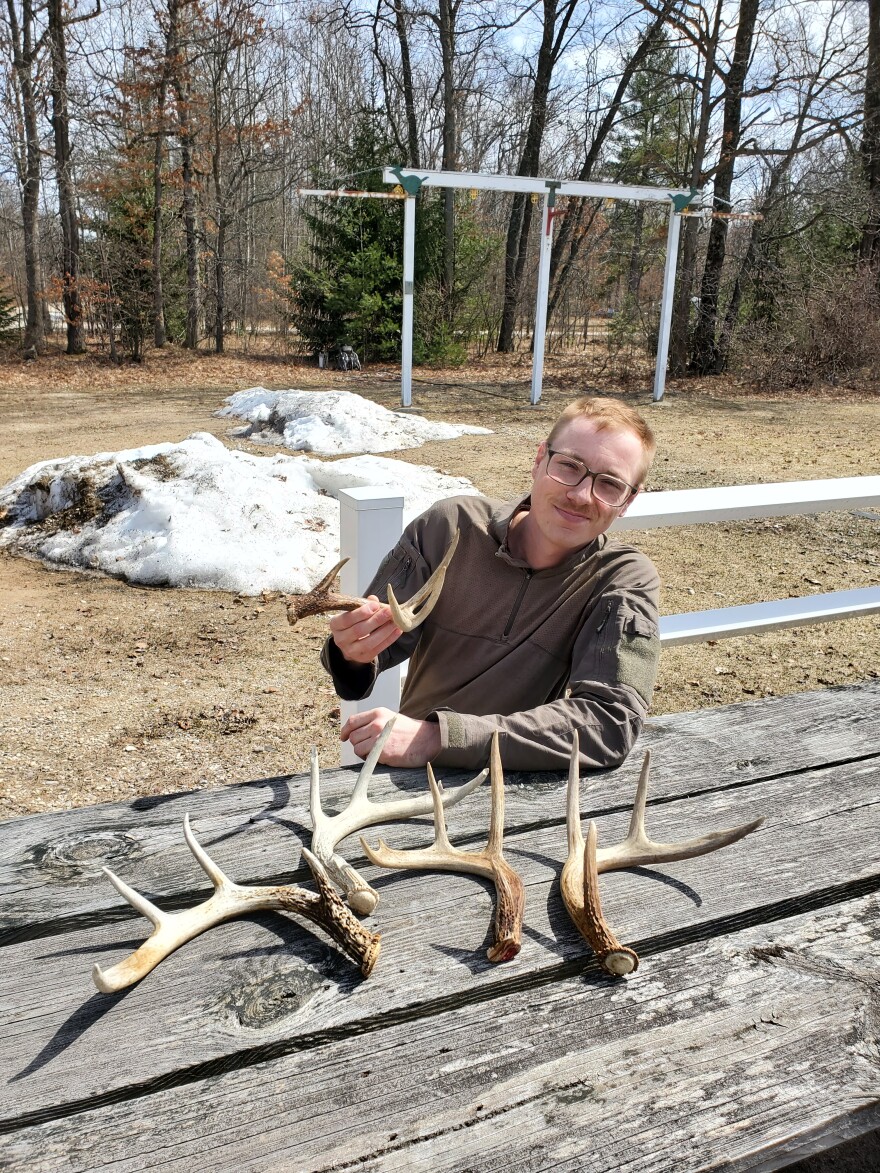Throughout the season, we’ll offer tips for spotting plants and wildlife.
Today, we have news of bluebirds and a hobby you might want to pick up: shed hunting.
BRINGING IN THE BLUEBIRDS
This week we’re looking for eastern bluebirds.
Greg Miller is the Michigan Bluebird Society coordinator for Benzie, Grand Traverse, Leelanau and Manistee Counties, and he says bluebirds arrived on March 23, but flew south again after the snowstorm.
“They feed off the insects on the ground, so we need to have the snow off the ground and warmed up a little bit. Once that happens, they get going with their nesting,” Miller explained.
He expects them back any day now, so he advises keeping an eye out for these brilliant, royal blue songbirds that are related to the American robin. And while we’re waiting, he says it’s a good time to build a nest box to attract them.
“The birds don't really care what style house you build for them. The main thing they're looking for is a nesting site which is hollow. It used to be hollow trees or fence posts. That’s why boxes are so helpful now is because those things have disappeared to a large degree,” according to Miller.
After you build your box, locate it in an open grassy field away from trees.

“Also keep your boxes away from sheds and outbuildings and barns and other structures where house sparrows may be nesting because they can be a very big problem as they may get into the nesting box and kill the bluebirds,” he added.

Greg Miller has built 100 bluebird boxes over the years and says if you have any questions, contact him.
SHED HUNTING: 'WHOEVER GETS THEM FIRST'
Male white tail deer grow antlers over the summer, reaching maximum size just in time for mating season. They keep the antlers through the winter and then shed them.
People who collect them call this shed hunting.
“They’re a unique treasure,” said Cody Carlson, director of the Dublin Heights Sports Club in Manistee County. “I’m the type of individual who likes to go out and look for articles or items that might not be as common as things that you can just buy in the store, something that you have to work for and go find and there’s the luck of the draw whether you’re going to find one or not.”

Carlson says shed hunters generally fall into three groups: those who go out specifically looking for antlers to learn more about the deer population, people who collect them just like others might collect Petoskey stones and others who just happen to find them when they’re spending time outside.
Carlson and his group fall into the latter category. They clean up trash in Manistee National Forest and sometimes they find a treasure which they usually save to use in educational programs.
Cody says people aren’t the only ones looking for antlers.
“You’re battling the wildlife — whoever gets them first," he said. "So when you pick them up, it’s a nice little trophy. If not, usually the porcupines or another animal will get them first. It’s the cycle of life.”
It is legal in Michigan to possess shed antlers. But check with the property owner or manager to make sure it’s ok to carry them away. In general, it’s okay on most state land and not okay in Sleeping Bear Dunes National Lakeshore.
LILACS, HONEYSUCKLES, AND THE ARRIVAL OF SPRING
Studying natural phenomena as they change with weather and time is called phenology. That’s what we’ll be doing in our weekly guide, as we tell you about spring happenings over the next couple of months.
The USA National Phenology Network tracks the advance of spring and has a cool time-lapse map of the U.S. showing how far north spring has advanced so far this year. It’s arriving several days to even weeks earlier than average over much of the country.
The network uses the first leaves visible on lilacs and honeysuckles as indicators of spring’s arrival.
Ironically, lilacs and most honeysuckles are not native to the U.S. But like many non-native species, they’re among the first to leaf-out and start growing. That’s what makes them good indicators.
And it also makes them out-compete many native species.
If you want, you can be a part of citizen science by reporting your sightings. Sign up on the USA National Phenology Network's website.
Let us know what you’re seeing! If you find any sheds, send us a photo. You can reach us at ipr@interlochen.org.
More from IPR's Red Pine Radio:
Want more news from northern Michigan? Subscribe to IPR 's newsletters!




